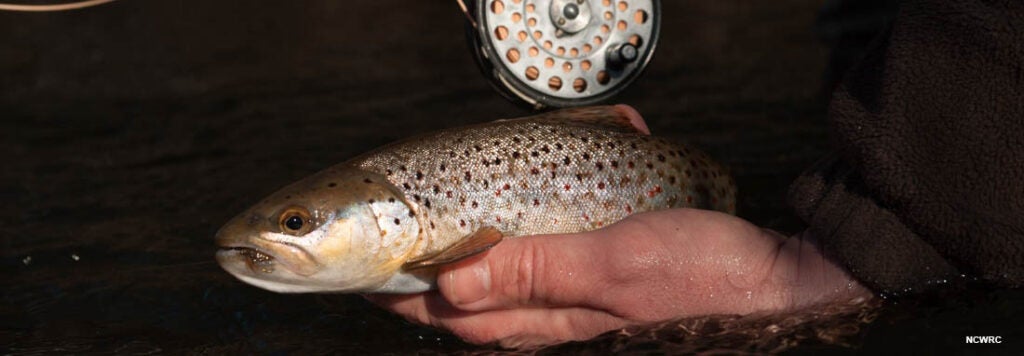Wanna step outside? Study says mountain trout fishing worth $1.38 billion to North Carolina’s economy. How much might flounder be worth?
Published 12:00 am Thursday, December 14, 2023

- North Carolina's mountain trout fishery is worth $1.38 billion to the state's economy, according to a survey published by the N.C. Wildlife Resources Commission. - N.C. WIldlife Resources Commission
|
Getting your Trinity Audio player ready...
|
By Dan Kibler
For the Clemmons Courier
A couple of years ago, when the N.C. Marine Fisheries Commission decided to change its plans mid-stream and give more of the annual allotment of flounder to commercial instead of recreational fishermen, I wondered what the economic impact might be on the state’s tourism industry, what with the commission allowing fishermen to only catch one flounder per day, and only for two weeks in September.
How many people who loved gigging flounder would quit taking trips to the coast? For how many people would it be the straw that broke the camel’s back — already limited to four speckled trout and one redfish per day — that would send them to waters other than those off the North Carolina coast to fish?
I thought about that again this past fall when part of our family decided not to take a week’s vacation on the Outer Banks and instead spend a week at the flounder capital of South Carolina, Murrells Inlet, where two good fishermen could still fill a cooler with the flounder allowed in a day’s fishing.
I figured, well, some property owner in Dare County loses a bunch of money not getting that week’s rental fees; the real estate company that rents the property misses out on its fees, which trickles down to less money for the people that clean the cottage before our arrival. And what kind of money did we spend at a Kroger on U.S. 17 just across the bridge from Murrells Inlet instead of the Food Lion in Avon? Factor in what the restaurant community in Murrells Inlet got that would have gone to similar places on the OBX. I figure easily $3,000 to South Carolina instead of North Carolina. Wonder how many families mirrored ours, and how much the total cost of a short, almost useless flounder season is to North Carolina.
There are people who can actually put dollar-value numbers to those kinds of activities, economists who deal in things like multipliers and travel dollars and the like. While I haven’t seen any study on how the flounder fiasco has affected North Carolina tourism, the N.C. Wildlife Resources Commission recently released a report on the economic impact of mountain trout fishing in the Tarheel State.
The numbers are staggering. From a survey of 25,000 anglers done earlier this year — a random sampling of resident and non-resident trout anglers — the commission discovered that fishing for rainbow, brook and brown trout in North Carolina’s mountain streams has an annual economic impact of $1.38 billion. That’s “billion” with a “B.”
The survey showed that 370,000 anglers spent 4.6 million days on North Carolina waters in pursuit of trout — 322,000 residents and 48,000 non-residents. The average angler took nine fishing trips for trout each year, for a total of 12½ fishing days.
The average daily fishing trip — travel, lodging and all other expenses combined — costs $240. That comes to $587,553,393 for all trip-related expenditures — with lodging, vehicle and boat fuel and meals leading the way — and $770,000,000 on equipment expenditures. And the economists who contributed to the survey reasoned that for every one of those dollars spent, the state economy got a $1.93 return. The report said trout fishing supports 11,808 North Carolina jobs.
The commission highlighted the differences between the 2023 study and a study published in 2015 that reported a $383 million economic impact. Why the huge difference? Start with a 29% average increase in the cost of living, but add in a 53% increase in the number of fishing license holders and an increase in the number of trout anglers among total anglers from 18.5% to 32%.
Ten percent of anglers responding to the survey said they did most of their fishing in Ashe County, with Watauga, Avery, Jackson and Haywood rounding out the top five as the most popular counties for trout fishing in North Carolina. That’s an interesting note because it shows that the counties closest to the state’s biggest population centers get the most fishermen — not the counties considered to contain the state’s best trout waters.
Hatchery Supported Trout Waters (58 percent) were the most popular waters fished, with Delayed Harvest Trout Waters (26 percent) coming in second.
Doug Besler, the Commission’s fisheries supervisor for the mountain region, said, “Given the recreational importance of trout fishing, it’s important … to understand public perceptions on management of trout and expenditures on trout fishing. These surveys put an economic value on the resources we manage and help focus our program and infrastructure, such as capital investments in modern fish hatcheries.”
So, I wonder if there’s a really sharp grad student in some university business program that would do a survey to determine the value of those flounder to the state’s tourism industry and the overall economy. How much of that money has been lost over the past 10 years as marine fisheries managers have consistently valued the commercial fishing industry over recreational fishermen?



